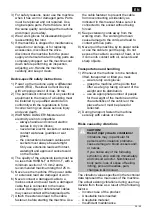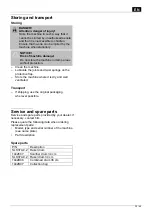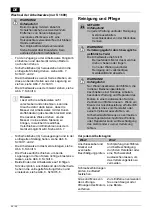
32 / 49
EN
Operation
Check before use!
DANGER!
Danger of injury!
Do not operate the machine unless you
did not find any faults. If a part has
become defective, make sure to replace it
before you use the machine again.
Check the safe condition of the machine:
– Check it for visual defects.
– Check that all parts of the machine have been
securely fitted.
Adjusting the handlebar height
►
Page 2, Fig. 2
– Undo the clamping screw (10).
– Set the handlebar to the desired height.
– Retighten the clamping screw (10).
Adjusting the working depth
For the first operation of the new working drum,
only working position
1
may be used.
Settings
2, 3, 4
are only necessary after wear of
the blades / aeration springs.
Depending on the degree of wear, gradually set
drum lower, starting from position 2.
NOTICE!
Risk of damage to the machine!
The optimum working depth is obtained
when the blades / aeration springs of the
working drum are inserted 2-3 mm into
the ground. Excessive working depth can
result in overloading of the motor and
damage. Be sure to set the working
depth accordingly.
►
Page 2, Fig. 1
– Switch the machine off.
– Raise the machine at the front.
– Adjust the desired depth of the working drum
using the rotary knob (6).
– Lower the machine again.
Attaching the cuttings bag
►
Page 3, Fig. 4
– Lift the protective flap (5) and hold.
– Slot the collecting bag (7) into place.
– Ensure that the bag has slotted into place
securely.
Connecting the product
►
Page 4, Fig. 5
– Pull the extension cable through the cable grip
(8) as illustrated, and connect it to the terminal
on the machine's switch.
– Insert the extension cable coupling into the
mains.
De-thatching/aerating
DANGER!
Danger of injury!
Before starting work, always check the
ground and remove all objects which
could be thrown by the machine.
DANGER!
Danger of injury!
Never release the operating lever while
working.
Scarification:
The working (raker) drum rotates and removes the
felt layer formed by moss, lichen and weeds and
conveys the scarified material to the outside or into
the collecting bag. During working the knives
penetrate the ground and therefore ensure that the
lawn is loosened and absorbs nutrients better.
We recommend scarifying the lawn in spring
(April/May) and autumn (October).
Aerating:
The working (aerator) drum rotates and combs the
lawn or aerates the slightly mossy areas. The
removed moss is conveyed outwards or into the
grass catcher. During aeration the surface of the
ground is scratched; this improves water drainage
and facilitates the absorption of oxygen.
We recommend aerating the lawn during the entire
growing period as and when required.
Note:
The combined work cylinder combines
both work activities together.
►
Page 4, Fig. 6
– Position the machine on a level lawn surface.
– Tilt the machine back so that both front wheels
are free and the working roller does not touch
the ground.
– Press the operating safety lock (9) and hold
down.
– Pull and keep hold of the operating lever (1).
– Release the operating safety lock.
– Wait until the motor has reached its maximum















































